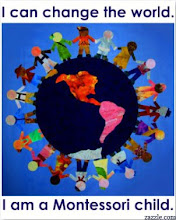Pribor se sastoji od 10 brojevnih gredica i od 10 drvenih pločica s brojevima od 1 do 10.
Cilj ove vježbe je pridruživanje simbola (brojke) količini (broju) - i obrnuto, te priprema djeteta za računske operacije. U mojoj vrtićkoj grupi djeca ovu vježbu najčešće rade nakon 4 ili 4,5 godine. Važno je da dijete (kojem ću pokazati ovu vježbu) potpuno samostalno može napraviti
vježbu s brojevnim gredicama i
vježbu s brojkama od brusnog papira (jer je u ovoj vježbi bitno da dijete imenuje simbol za broj).
~
Material consist of 10 number rods and 10 printed numerals from 1 to 10 on wooden tiles.
The aim of this exercise is to match the number to numeral (the symbol) - and vice versa, and prepare the child for mathematical operations. In my classroom, kids mostly work this exercise when they're 4 or 4.5 years old. It is important that child (which I will demonstrate this exercise) can do Number rods and Sandpaper numerals exercises independently (it is important, in this exercise, that a child already knows to appoint a numeral).
Vježbu s brojevnim gredicama i brojkama pokazujem u dva dijela (
oba dijela čine osnovnu prezentaciju):
- pridruživanje brojke brojevnoj gredici
- pridruživanje brojevne gredice pločici s brojkom
I show the exercise with number rods and numerals in two parts (both parts are the basic presentation):
- joining numerals to the number rods
- joining number rods to numerals
Ad 1.
Dijete na tepih donosi brojevne gredice na
već poznat način. Zatim donosi kutiju s brojkama. Prvi put odgojitelj pokazuje kako se iz kutije vade brojke. Kao što se može vidjeti na fotografiji, brojke se slažu po redu. Nakon svake izvađene brojke, odgojitelj prvo pita dijete poznaje li tu brojku a dijete ju imenuje (naučilo je imenovati brojke u
vježbi s brojkama od brusnog papira koju ću opisati drugom prilikom).
~
Child (on the way already known) bring number rods on the rug. Then she bring the box with the numerals. The first time teacher shows how to extract numbers from a box. As can be seen in the photograph, the numerals are placed in a column. After all the numerals were placed, the teacher first asks whether the child knows to appoint the numeral and the child shall be appointed (she learned the names of the numerals in the Sandpaper numerals exercise, which I will describe some other time).
Kad smo sve brojke izvadili iz kutije i stavili na tepih, odgojitelj uzima gredicu br. 10 (najveći broj), izbroji segmente opipavajući dlanovima (opis i fotografija su u
ovom postu), te gredici pridružuje pločicu s brojkom 10 [odgajatelj pokazuje način rada s brojkom 10 jer se dijete prvi put susreće (u Montessori vježbama iz matematike) s tom brojkom - u brojkama od brusnog papira je naučilo brojke od 0-9]. Brojke slažemo na desni dio gredice i između gredica ostavljamo mali razmak:
~
When we have all the numerals out of the box and put it on the rug, the teacher take the number rod no. 10, count segments with palms (description and photo are in this post), and joining the numeral 10 to the number rod no.10 [the educator shows the numeral 10 because child first encounters (in the Montessori exercises in mathematics area) this numeral - sandpaper numerals are 0-9]. We place the numerals on the right side of the number rods, and we leave some space between the number rods:
Ovisno o potrebama i interesu djeteta, gredice ne moramo složiti po redu. Ako ne slažemo po redu, sigurni smo da dijete ne radi mehanički.
~
Depending on the needs and interests of the child, number rods do not have to be placed in order. If we do not place it in order, we are sure that the child does not work mechanically.
Ad 2.
Pločice s brojkama vratimo na desni rub tepiha (naravno, samo ako radimo s dešnjakom):
~
We put tiles with numerals back on the right edge of the rug (of course, only if we work with right-handed):
Odaberemo jednu pločicu s brojkom (npr. br. 4), i stavimo ju na sredinu, ispred djeteta:
Select one numeral (eg no. 4), and put it in the middle, in front of the child:
Djetetu kažemo: Pronađi gredicu broj 4. Ono ju pronalazi, izbroji crvene i plave segmente na poznat način (
opisan ovdje) i pridružuje brojku odgovarajućoj brojevnoj gredici.
~
We say to the child: Find number rod no. 4. She finds it, count red and blue segments, on the way already known (described here), and join the numeral to the appropriate number rod.
Nasumce izdvajamo brojke na pločicama, a dijete traži odgovarajuću gredicu.
We are taking numerals randomly, and child is looking for appropriate number rod.
Primjeri nekih dodatnih vježbi: / Examples of some extensions:
- Dijete odlaže brojevne gredice proizvoljno po sobi dnevnog boravka (na pod, na policu ili ormar...). Zatim uzima pločicu s brojkom i traži odgovarajuću brojevnu gredicu. Djeca isto mogu raditi i po nalogu. / Child put number rods across the classroom, as she wants (on the floor, shelf or closet ...). Now take the numeral and looks for the appropriate number rod. Children can also work per order.
- Odgajatelj djeci podijeli brojevne gredice i brojke. Svako dijete traži prijatelja koji ima broj za jedan manji ili veći od njegovog (ovisno o dogovoru djece ili nalogu odgajatelja). Mlađa djeca mogu istu aktivnost provesti tako da traže prijatelja s istim brojem. Kad su se parovi međusobno pronašli, brojevne gredice i brojke odlažu na tepih. / Teacher gives number rods and numerals to children. Every child searches for a friend who has one number smaller or bigger than his (depending on how the children agree, or what the teacher told). Younger children can do the same activity to seek a friend with the same number. When the pairs found themselves, they put number rods and numerals on the rug.
- Dijete izabire jednu brojevnu gredicu, izbroji segmente na njoj i hoda (na mjestu ili naprijed) onoliko koraka koliki je broj brojevne gredice. Ako je uzelo gredicu br. 6, treba hodati 6 koraka i naglas brojati svaki korak. Isto se može i samo s brojkama. Druga varijanta iste vježbe je da dijete stoji mirno dok broji, a kad kaže zadnji broj - čučne. Još jedna varijanta (indirektna priprema za parne i neparne brojeve) je da dijete čučne ili jače udari stopalom pri izgovoru parnog ili neparnog broja. / The child chooses a number rod, numbered segments on it and walk (on the spot or forward) as many steps as the number of number rod is. If she took the number rod no. 6, she should walk 6 steps and count each step out loud. The same can be done with numerals only. Another variant of the same exercise is to stand still while she counts, and when she says the last number - squat down. Another variant (indirect preparation for even and odd numbers) is that children squat down or march harder during the pronunciation of the even or of the odd number.
- Crtanje brojevnih gredica s ravnalom i bojanje. Djeca koja znaju, mogu napisati odgovarajuću brojku. / Drawing number rods with a ruler and coloring. Children who know how to also can write the appropriate number.
- Rad na udaljenim tepisima: na prvom su brojevne gredice, na drugom su brojke - nije bitno da li je sve složeno po redu ili nije. Starije dijete ili odgajatelj kaže djetetu: Donesi mi broj 7. Dijete treba na tepih s brojkama donijeti brojevnu gredicu br. 7, prebrojiti segmente na njoj i prisloniti pločicu s brojkom 7 na brojevnu gredicu. / Working on two distant rugs: number rods are on the first rug, numerals are on the second rug. It doesn't matter if you place number rods in order or not. Older child or teacher say to the child: Bring me the number 7. The child should bring number rod no. 7 on the rug, count the segments on it out loud, and lean the numeral 7 on the number rod.


Kad smo isto napravili sa svim brojevnim gredicama i brojkama, radimo obratno - brojke premjestimo na prvi tepih, a brojevne gredice na drugi tepih:
When we did the same with all number rods and numerals, we do the opposite - move the numerals on the first rug, and number rods to another rug:
- Dijete čita brojke na pločicama po redu i obratno. To je djeci poprilično komplicirano. / The child reads the numerals on the tiles, and then read backwards. It is quite complicated for children.
- Računske operacije s brojevima od 1 do 10. Dijete treba složiti brojevne gredice i brojke kao u osnovnom načinu rada (na početku ovog posta je opis): / Math operations with numbers from 1 to 10. The child should placed number rods and numerals as in the basic mode (at the beginning of this post is a description):
Zbrajanje: Svakoj brojevnoj gredici dodamo još jednu, odgovarajuću, gredicu tako da njihov zbroj iznosi 10:
Addition: Each number rod add another, appropriate, rod so that their sum is 10 :
9+1=10, 8+2=10, 7+3=10, 6+4=10
Brojevna gredica br. 5 je ostala sama, bez para. Nju okomito rotiramo na suprotnu stranu i kažemo: 5 plus 5 je 10, te pločicu s brojkom 5 preselimo na kraj brojevne gredice. Tako se nadomješta "nepostojeća", druga, brojevna gredica br. 5.
~
Number rod no. 5 is single, it has no pair. We rotate it vertically to the opposite side and say: 5 plus 5 is equal to 10, and move numeral 5 to the end of that number rod. It replaces the "nonexistent", another, number rod no. 5.
Ovo, što smo napravili s brojevnom gredicom br. 5, je zapravo indirektna priprema za množenje (5×2=10).
This, what we did with the number rod no. 5, is actually an indirect preparation for multiplication (5 × 2 = 10).
Oduzimanje: (nastavak gore opisanog zbrajanja) Prvo oduzimamo 10-5 (brojevnu gredicu broj 5 rotiramo natrag, vraćamo ju na početno mjesto - to predstavlja indirektnu pripremu za dijeljenje 10÷2=5) i kažemo: 10 minus 5 je 5. Također, sve ostale brojevne gredice s brojkama vraćamo na njihovo mjesto i naglas govorimo 10 minus 4 je 6, 10 minus 3 je 7 itd.):
~
Subtraction: (continued above-described addition) First deduct 10-5 (number rod no. 5 rotate back, return it to the initial position - it is indirect preparation for the division 10 ÷ 2 = 5) and say: 10 minus 5 equals 5. Also, the remaining number rods and numerals going back to their place as we speak aloud: 10 minus 4 equals 6, 10 minus 3 equals 7, etc.):
- Zbrajanje s dvije brojevne gredice: od dvije brojevne gredice radimo jednu gredicu - npr. broj 3. Uzmemo gredicu broj 2, izbrojimo segmente pa stavimo gredicu broj 1 pored nje, u nastavku. Na novonastaloj brojevnoj gredici prebrojimo do tri. Na kraj prislonimo pločicu s brojkom 3: / Addition with two number rods: we make one number rod of two other number rods with smaller number - for example number 3. Take number rod no. 2, count segments and put number rod no. 1 beside it, immediately behind it. We count to three on the new number rod. At the end of the new number rod lean numeral 3:
Oduzimamo na isti način: 3-1=2; brojevnu gredicu br.1 vraćamo ispod gredice br.2.
We are doing subtraction the same way: 3-1=2; number rod no. 1 put back, below number rod no.2.
Napomena: brojevna gredica br. 2 se "ponaša" kao gredica br. 5 (rotiramo ju, kao što je opisano i prikazano na fotografiji iznad, za gredicu br. 5): dijeljenje 4÷2=2 ; množenje 2×2=4
~
Note: number rod no. 2 is "behaving" as number rod no. 5 (rotate it, as described and shown in the photograph above, with the number rod no. 5): division 4÷2=2; multiplication 2×2=4- Zbrajanje i oduzimanje do 20: za primjer sam uzela brojevne gredice br. 10 i br. 2. U nastavku brojevne gredice br. 10 sam stavila brojevnu gredicu br. 2. Segmenti se naglas broje do 12 na već poznati način. Na zadnji dio novonastale brojevne gredice prislonimo pločicu s brojkom 1 i s brojkom 2 (jednu pored druge) ili pločicu s brojkom 10, a preko nule stavimo brojku 2:
~
Addition and subtraction to 20: I took a number rod no. 10 and no. 2 for example. I placed number rod no. 2 immediately beside number rod no. 10. The segments are counted aloud to 12 on the already known manner. On the last part of the new number rod (no. 12) lean numeral 1 and numeral 2 (next to one another); or a numeral 10, but cover zero with the numeral 2:



Napomena: zbrajamo brojeve čija je suma manja ili jednaka broju 20 jer dijete uči brojati do dvadeset tek u trećoj skupini pribora iz matematike (Seguinove ploče). Možemo spajati i više od dvije gredice (za brojeve veće od dvadeset) kada smo sigurni da je dijete za to spremno i da zna simbole za br. 20 i više.
~
Note: Summarize the numbers whose sum is less than or equal to the number 20 because the child learns to count to twenty in the third group of math materials (Seguin bards). You can connect more than two number rods (for the numbers greater than twenty) when you are sure that the child is ready for it and know the symbols for the number 20 or more.
I'm linking up to:










































































































